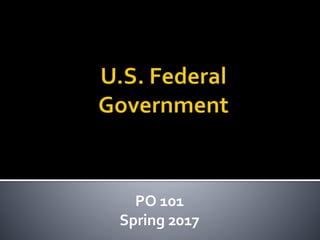More Related Content
What's hot
What's hot (20)
Similar to PO 101 Public Opinion
Similar to PO 101 Public Opinion (14)
The Correlation Between Social Media and Voter Turnout

The Correlation Between Social Media and Voter Turnout
Health Care Essay. argumentative essay about universal healthcare

Health Care Essay. argumentative essay about universal healthcare
Chong-Druckman-FramingTheory Chong-Druckman-FramingTheory

Chong-Druckman-FramingTheory Chong-Druckman-FramingTheory
More from atrantham
More from atrantham (20)
Recently uploaded
This presentation was provided by William Mattingly of the Smithsonian Institution, during the fourth segment of the NISO training series "AI & Prompt Design." Session Four: Structured Data and Assistants, was held on April 25, 2024.Mattingly "AI & Prompt Design: Structured Data, Assistants, & RAG"

Mattingly "AI & Prompt Design: Structured Data, Assistants, & RAG"National Information Standards Organization (NISO)
God is a creative God Gen 1:1. All that He created was “good”, could also be translated “beautiful”. God created man in His own image Gen 1:27. Maths helps us discover the beauty that God has created in His world and, in turn, create beautiful designs to serve and enrich the lives of others.
Explore beautiful and ugly buildings. Mathematics helps us create beautiful d...

Explore beautiful and ugly buildings. Mathematics helps us create beautiful d...christianmathematics
APM Welcome
Tuesday 30 April 2024
APM North West Network Conference, Synergies Across Sectors
Presented by:
Professor Adam Boddison OBE, Chief Executive Officer, APM
Conference overview:
https://www.apm.org.uk/community/apm-north-west-branch-conference/
Content description:
APM welcome from CEO
The main conference objective was to promote the Project Management profession with interaction between project practitioners, APM Corporate members, current project management students, academia and all who have an interest in projects.APM Welcome, APM North West Network Conference, Synergies Across Sectors

APM Welcome, APM North West Network Conference, Synergies Across SectorsAssociation for Project Management
This presentation was provided by William Mattingly of the Smithsonian Institution, during the third segment of the NISO training series "AI & Prompt Design." Session Three: Beginning Conversations, was held on April 18, 2024.Mattingly "AI & Prompt Design: The Basics of Prompt Design"

Mattingly "AI & Prompt Design: The Basics of Prompt Design"National Information Standards Organization (NISO)
Recently uploaded (20)
Mattingly "AI & Prompt Design: Structured Data, Assistants, & RAG"

Mattingly "AI & Prompt Design: Structured Data, Assistants, & RAG"
Measures of Central Tendency: Mean, Median and Mode

Measures of Central Tendency: Mean, Median and Mode
Explore beautiful and ugly buildings. Mathematics helps us create beautiful d...

Explore beautiful and ugly buildings. Mathematics helps us create beautiful d...
Seal of Good Local Governance (SGLG) 2024Final.pptx

Seal of Good Local Governance (SGLG) 2024Final.pptx
Ecological Succession. ( ECOSYSTEM, B. Pharmacy, 1st Year, Sem-II, Environmen...

Ecological Succession. ( ECOSYSTEM, B. Pharmacy, 1st Year, Sem-II, Environmen...
Mixin Classes in Odoo 17 How to Extend Models Using Mixin Classes

Mixin Classes in Odoo 17 How to Extend Models Using Mixin Classes
APM Welcome, APM North West Network Conference, Synergies Across Sectors

APM Welcome, APM North West Network Conference, Synergies Across Sectors
SECOND SEMESTER TOPIC COVERAGE SY 2023-2024 Trends, Networks, and Critical Th...

SECOND SEMESTER TOPIC COVERAGE SY 2023-2024 Trends, Networks, and Critical Th...
Web & Social Media Analytics Previous Year Question Paper.pdf

Web & Social Media Analytics Previous Year Question Paper.pdf
Mattingly "AI & Prompt Design: The Basics of Prompt Design"

Mattingly "AI & Prompt Design: The Basics of Prompt Design"
PO 101 Public Opinion
- 4. Public opinion is: (1) Collective political beliefs and attitudes, (2) of the public, or groups within the public, (3) on matters important to government.
- 6. Salience Issue’s important to a person or public Example: Gay Marriage vs. Economy Stability Are issues likely to stay the same or change? Direction Does public favor or oppose issue? (agree or disagree) Intensity How strongly do people feel about issues?
- 9. Children learn about politics through informal conversations with parents at meal times, gatherings, etc.
- 10. Children are broadly politically socialized through formal education.
- 11. A peer group can include friends, neighbors, and co-workers. They can reinforce or refine about the political system.
- 12. Religious institutions teach values relating to law and authority, equality, and social justice.
- 13. Citizens turn to political leaders and institutions when forming their political opinions. Different political ideologies have different opinions on issues.
- 14. Political socialization can depend on what the media covers, how they cover it, and the accessibility of coverage.
- 16. Younger people may have different attitudes and beliefs from older generations. Example: Those coming of age during WorldWar II versus those who grew up during theVietnamWar
- 17. National events like Watergate and 9/11 can affect someone’s political socialization.
- 20. Economic Self-Interest Ideology and Partisanship Education Age Gender Race and Ethnicity Religion Geographic Region
- 39. This map represents voting trends in the last four presidential elections (2000, 2004, 2008, and 2012). Which states are more Republican? Which states are more Democratic?
- 47. George Gallup
- 49. Ambiguous Questions Questions that are not clearly defined What is your income? How many children? Leading Questions Encourages respondents to choose response because researcher expects it; “social desirability” Don’t you think that global warming is a serious environmental problem? Word Choice Helping “the needy” vs. “those on welfare” “Going toWar” vs. “FightingTerrorism”
